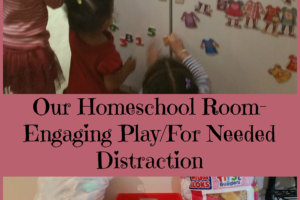Math-U-See Review
I have been using the Math-U-See curriculum for three years. We started with the Alpha level when my second daughter was in ‘first grade’. We are about to begin the Gamma level (might be equal to grade 3) with my eldest.
My review would be focusing on elementary grades.
Being upfront, I like this curriculum for my family. However, I am going to give my honest opinions as I see them: the good and the bad. I have NOT been paid by Demme Learning (the company that creates the curriculum) at this time. I have bought all the materials spoken about with my funds. Thus all opinions are my own.
Now that that is out of the way.
I first have a few things to say about the primer level, and then I will give the pros and cons of the curriculum.
The Primer Level…
The Primer Student Workbook at $34.00 is too expensive for what would be equivalent to a kindergartener’s workbook. If you were to get the entire universal set at $136.00, that is way too much for a math program for kindergarten.
Preschool and kindergarten years you do not have to spend money on much if any, specific program for learning. There are tons of different options, which I would not delve into here, for the sake of staying on point.
If you do have the funds, and wanted your child to stay with one program, then it a good start to the Math-U-See program.
My first daughter did not use the primer and is doing very well in the program. I did buy it for my second daughter to try. After trying it, I can say my first did not miss anything by skipping it and starting at the Alpha (‘first grade’) level.
It should also be noted, as per their website, that if a student has significant cognitive issues, the Primer pace may not be suitable. You can contact them if this is applicable.
And the point above would lead to my last statement about the primer level. It does not focus a lot on number copy work, which I think is still necessary at this stage.
The Program As A Whole…
Pros:
- It is a mastery program. It progresses through the concepts of math in a logical sequence, taking an orderly and progressive approach to math. The student can spend as long or as little on each math concept until mastered.
- It covers K-12.
- You don’t need to be good at math to teach Math-U-See. Forgot most of what you learned in school? No worries. You will relearn right alongside your kid and teach them confidently.
- It builds on each other. Addition and subtraction are drilled in the beginning. This is important when it comes to multiplication and division. Since they are both repeated addition and subtraction, respectively.
- It is math that you see! Your kids get to see and understand what they are doing.
- There are DVD instructions that can be purchased for each level. You, the teacher (or you and your child) watch the instructional DVD. It gives step by step guide for the new topic. Mr. Demme explains the concept and then work through a few examples. So If you’re a bit rusty in math, it removes that worry but also works to sharpen your math skills.
- Before each new level, the DVD lectures give tips before moving on. Such as making sure your child understands the concepts taught in the previous level before moving on. You are moving at your child’s pace, even though it’s tempting to try and finish on a schedule. I like to listen to it to get my money’s worth, but it seems a lot of people skip it.
- A Build It, Say It, Write It, philosophy. The building for visual aid, saying it for auditory aid and then writing or doing it themselves. During the Alpha level, we applied this concept a lot. But once my child starts picking up on the concepts, I don’t make this a mandatory. But the system is there to put in place when issues arise.
- Also for Visual or Spatial Learners, the aid of the blocks acts as a visual guide, when needed, in the learning process.
- You only buy the blocks once, and use it throughout the program.
- Free printable worksheets for most topics are available for free on their website. Click on the E-Learning Tab. I print these out sometimes if we completed all the worksheets, but my child still needs practice. The questions are randomly generated, and you can print multiple sheets.
- They also have a free online drill page. You the parent select the concepts you want your child to learn, and then they can work through the problems. My girls have not used this feature yet, but I have tested it.
- It prepares the student not only to be able to answer using math operations. But how to apply those math operations when doing word problems or real life scenarios. I can attest that I have noticed my kids getting much better with word problems. I am working on them writing out the full answer to the question asked. E.g., 15 flowers as suppose to only 15. That way, I can see they understood their answer in relation to the problem.
- They have an online placement tool if you are uncertain where your child should start.
- There is an ample amount of practice sheets. Each new concept has seven sections of problems you can work through (but you do not need to do all). Worksheets A-C are lesson practice sheets. D-F are systematic review sheets, reviewing that lesson, and a few questions based on previous topics. And worksheet G are application and enrichment pages that can be used at any time if so desired to test your student.
- The instruction manual. Besides giving you as the parent written guide for the concepts ahead. It also includes the answers to worksheets A-F. During the Beta level, I found this was very helpful. I have two, soon three, sets of corrections to do. So this helped with time efficiency. I did not use it much during the Alpha stage.
- For each level (except the primer) you can buy the tests book which provides further practice. In one of my previous videos, during the Math-U-See section (around13:05), I explain how I use these, which is a little different than intended. I use them after we have finished the level as a final review. That way works perfectly for us.
- I can tell my daughters are understanding math as they can explain their workings back to me when asked.
- Each workbook comes with a tracking sheet at the front. You have the option to fill these out as you progress and add to your records at the end. We have not needed to use them yet.
![]()
Cons:
- Setting up for watching the DVD’s can be time-consuming. This will depend on how quickly your child is grasping the concepts. If you’re doing one concept per week, this is no issue. However, if your child understands the concepts quickly, watching more than one video a week can become time-consuming. Whenever this happens now, which is not as much as in the beginning, we watch a video the evening before or early that morning.
- The program is on the expensive side, considering it is one subject.
- I find the blocks by themselves to be expensive at $83.00. As stated above, they are used throughout the program, but I still find the price a bit steep.
- The Primer level is too expensive for what is a kindergarten workbook.
- The only components you can buy easily as stand-alone items are the Integer Blocks and the Skip Count CD and Book. All the other pieces come as a ‘pack’. For example, last year, I needed a new Alpha workbook and had to call in to be able to buy the book by itself. They were accommodating and sold it to me. But, they had to either separate a pack to do so or have one that was left from another separated kit. I hope that makes sense.
- The use of the ‘t’ terminology for the teen numbers. Even though I get the concept and it helped in the beginning while doing place value. It soon became confusing so we eventually just dropped it. E.g., instead of saying eleven, twelve, thirteen, you would say onety-one, onety-two, onety-three.
- The worksheets are all in black and white. Right now, that is not an issue as they have the colorful blocks. But depending on the student, this may or may not be an issue.
- Math-U-See is sequential. The downside to this is that some topics that a child around the same ‘grade level’ might have been introduced to already are a bit later if using the Math-U-See program. Examples are Telling Time and Money. I am not too worried about that, though if in the end, they have a good understanding of math. If you are concerned you can introduce it earlier if you would like. We did that for time and money using The Complete Book of Time and Money. And these three also. But know it is not necessary.
- There are no answers to the application and enrichment pages (worksheet G).
Also Worth Mentioning…
It is a Christian based curriculum. I remember one instance where reference to the walls of Jericho was made during an Alpha video. Although this is not an issue for us, I thought I should mention it. It is not overly ‘Christian’ if that is a concern of yours. For the most part, he deals with the facts of math. At least so far.
In Summary…
Like we all know, no curriculum is perfect. What might be an excellent fit for me, and my household may not work for you at all. Buy at this point in our journey after tossing up the pros and cons we are sticking with Math-U-See for now. Not only do I see my kids gaining a good grasp of math. But I am learning those concepts right alongside them.
If that ever changes I will update.
Hope my review was helpful, if I come across or remember more points worth mentioning, I will update the post.
Until then, thanks for reading and happy homeschooling!
Questions…
What is your math curriculum of choice? Do you use Math-U-See? What math curriculum (physical or online) would you recommend trying?
Until next time, happy homeschooling.




















1 Comment
Leave your reply.